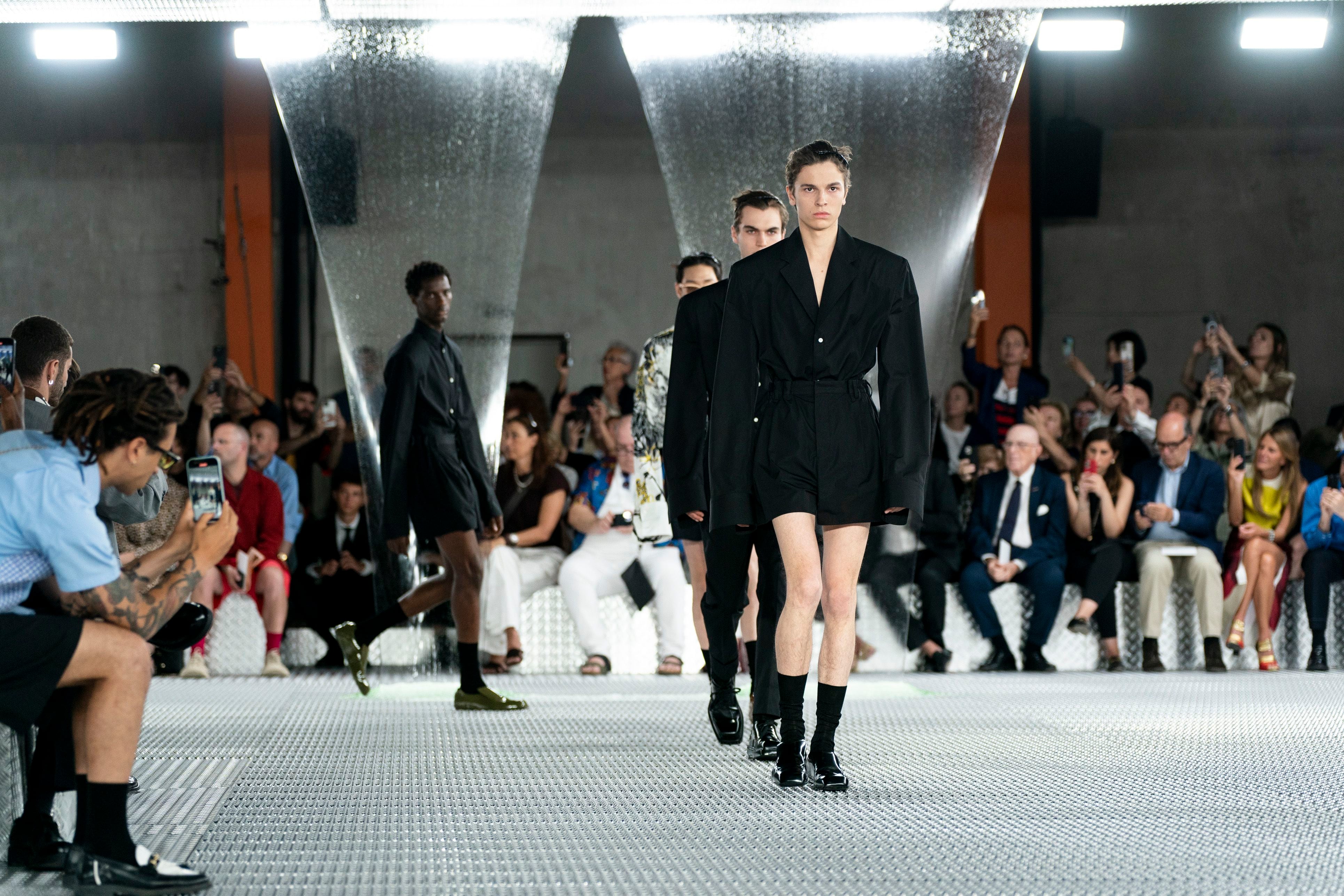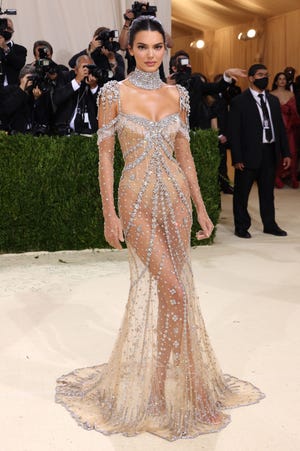What Clothes Maketh the Man?
In recent cycles, the deconstruction of the male identity has been central to fashion’s menswear conversation and the men’s fashion week that closed in Milan on Monday night was all about finding new ways of looking like a man. The drive to dismantle traditional manhood came, this time around, with a reductionist bent. This, by itself, wasn’t new. Minimalism, in the hard-edged, industrial 90s vein, is all the rage, but what was interesting was the range of temperatures on offer, ranging from the rather chilly to the… warm.
At DSquared, there was preppy porn, complete with “Very Important Penis” spelt loud on pornstar Rocco Siffredi’s t-shirt, but the brand has been brash and sultry since its inception. Elsewhere, the goings seemed to reflect our prudish, even sexless times.
Surprisingly, Prada, the undisputed temple of robotic masculinity, came with mild acknowledgment of sexuality this season. Raf Simons’ adolescent obsessions and Mrs Prada’s solid bourgeois leanings, peppered with their art obsessions came together in a way that brought the body (if still extra lean and not long past puberty) to the fore, inside a cold metal cage with dripping slime drawing liquid walls all around: part Alien, part erotic bodily secretion.
As a gesamtkunstwerk, the show was masterful, not a single element out of place. Fashion-wise, the collection proposed a masculine silhouette that paradoxically recalled a certain 1940s femininity: prominent shoulders, cinched waist, rounded hips. Most of it was very short with embellishment creeping in in the form of fringes and origami. It made for an assured outing that would perfectly translate — sensuality included — into something for women: fluidity made real. And yet, Prada’s agenda-setting power was missing. Not long after the show was over, the idea already felt somehow dated. But that’s the curse of today: immediate obsolescence. Fighting it requires a serious subversion of the status quo, which was not the case at Prada.
The sexual temperature was high, in a rugged kind of way, at Magliano. Following his Karl Lagerfeld Prize win at the latest LVMH Prize, all eyes were on designer Luchino Magliano. He has a wonderful way with sartorial roughness; the herald of a kind of working-class, debauched elegance with a mix of skilful deconstruction, carnality and spontaneity. The clothes he makes look like a work in progress: they inhabit the space between formality and workwear, and emanate a strong sexual energy, but also the poetry of real life, the consumption of existence.
Magliano is a force to be reckoned with: the baton bearer of a distinctly Italian way of doing things, rooted in product yet soulful. It’s an approach that Giorgio Armani keeps fine tuning year after year, decade after decade, in a process that is both heroic in its endurance and effortlessly elegant in its output. This season Armani was being Armani once again: fluid and sensual in his own masterful way, not a pair of bermudas in sight.
This was a season of shorts, in fact, but despite the amount of skin on display, the goings were rather chilly. The Valentino show, the brand’s first stand-alone men’s outing in a while, and the first in a long time in Milan, where Mr Valentino first launched menswear in 1985, took place in the main courtyard of the Università Statale and featured mostly shorts
In a supreme effort at cultural storytelling, the invitation came with pink-branded copies of author and New York Times T magazine editor Hanya Yanagihara’s morbid, dare we say pornographic detour across disaster and resilience A little Life. Passages from the book were also printed, Junya Watanabe-style, on jeans and other items of clothing. A long-awaited acceptance of masculine fragility was the theme here, but that hardly translated into the offer: immaculate, generously sized, minimal and rather martial looking tailoring in arrays of black and white and bonkers painterly hues. In other words, it was trademark Pierpaolo Piccioli. To be sure it was impeccably executed, and yet the approach somehow looked stale.
Forever minimalist Neil Barrett likes his fashions neat, pragmatic and efficient. With the fashion tides flowing back to where he has always been, he is enjoying the moment, but bringing a little more life and blood to the offer would help. Matthew Williams is another die-hard reductionist: at Alyx he keeps exploring the harsh, urban side of pared down, assuredly running the thin line that separates the simple from the anonymous. Even the usually colourful Massimo Giorgetti this season brough MSGM to new, simpler territories. Inspired by the sunsets of Tanzania, he delivered what was probably his most accomplished collection to date, all tailored separates and, erm, sunset prints, not a sweatshirt in sight. A little flavour was lost, a little maturity was gained, and that’s what growing up is about. Meanwhile, at Tod’s, Walter Chiapponi was more focused than ever, delivering a sharp take on Italian elegance.
Tailoring is still Milan’s forte, in different degrees of ease and innovation. LVMH Prize winner Satoshi Kuwata delivered a masterful lesson in deceptively simple tailoring at Setchu, bridging East and West through flat, multipurpose shapes that were both rigorous and playful; precise, rather than cold. The tailoring is always extra supple at Brioni, where Norbert Stumpfl keeps carving a uniquely subtle niche of utter preciousness and total effortness. Meanwhile, things were both classy and debauched at Umit Benan, a maverick who deserves more attention.
At Zegna, Alessandro Sartori keeps refining a take on tailoring that is progressive and innovative while still being based on traditional craft, in terms of both material and technique. Having ditched the rigidities of the suit, let alone the tie, Sartori has created a system of top, bottoms, underpinnings and accessories in which everything goes with everything, and possibilities expand. The result was efficient and responsible, as well as gentle and intelligent.
Stripping down came with a side of amped up sensuality at Dolce & Gabbana, which has moved the sartorial action to milder territories — joining a contingent that includes Dior’s Kim Jones and Valentino’s Piccioli — while maintaining a distinctly mediterranean signature. The duo’s new outing was concise and to the point: a sharp silhouette in a sea of black, white and grey, lean shapes, ample volumes, lots of draping and no decoration. At Emporio Armani, whiffs of the East and nods to North Africa coalesced in a taut line that felt energetic and modern, pared down in the most expressive of ways, an exciting direction for Mr Armani’s younger line.
Overall, the mood of Milano fashion week was youthful: not in the sense celebrating the young, but rather embracing the kind of radiant energy that youth carries. The Etro man, a blanket in his hands or turned into a coat, looked a lot less mincing and dreamy than usual: a skater of sorts, all floppy volumes, stellar knitwear, rhythmic patterns and allegories on football t-shirts. Nothing moving the conversation forward, but appealing and desirable nonetheless.
At Simon Cracker, a certain juvenile rebellion is a given, which is part of the charm of this young upcycling brand. Meanwhile, the mood was easy and windswept at JW Anderson: an experiment with elementary forms, from rugby shirts to shorts, from v-neck jumpers to shirts, which was absurd and provocative in its obviousness. Anderson has the rare ability to get a conceptual twist out of a certain heightened plainness. As much as the approach is increasingly looking like a formula, Anderson delivers the goods. His vision exudes an aloof chill that is somehow also hot, adding a further layer to the deconstructed man and his temperatures.

:quality(70)/cloudfront-eu-central-1.images.arcpublishing.com/businessoffashion/UR5OTG2ECRBNRHXSKNWIRHS3QE.jpg)


:quality(70):focal(1071x1377:1081x1387)/cloudfront-eu-central-1.images.arcpublishing.com/businessoffashion/FBF3TUQNONCL5HJN5JNTONRDSI.jpg)

